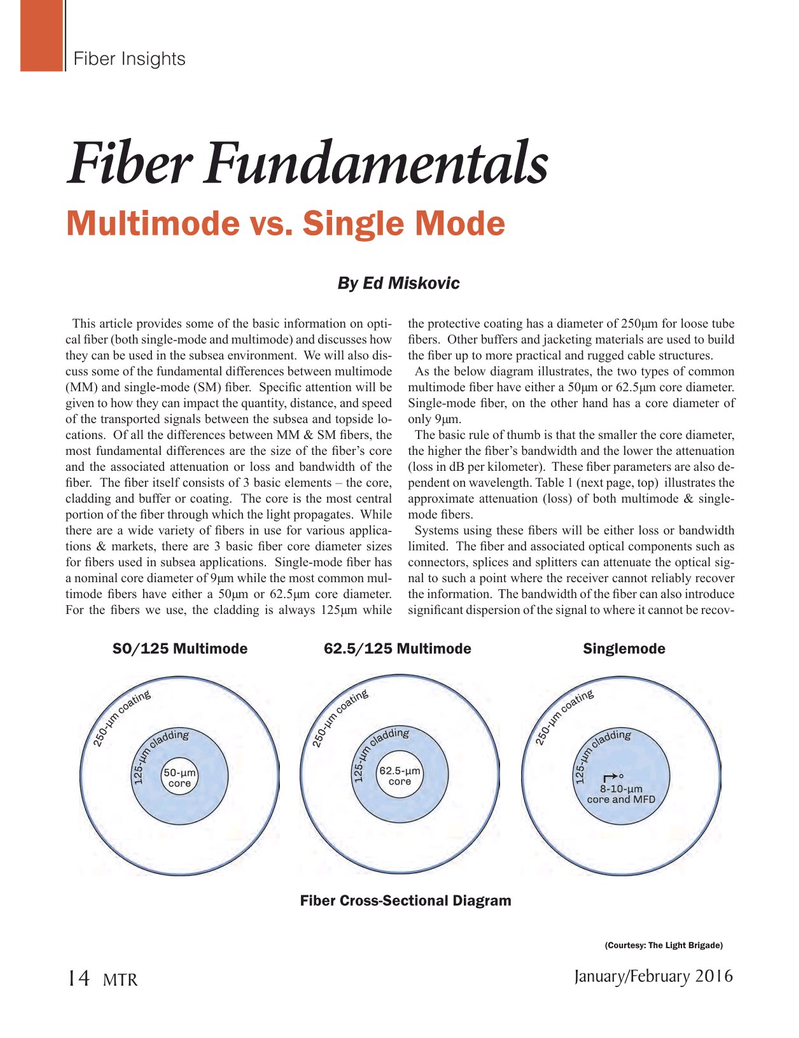
Page 14: of Marine Technology Magazine (January 2016)
Underwater Vehicle Annual: ROV, AUV, and UUVs
Read this page in Pdf, Flash or Html5 edition of January 2016 Marine Technology Magazine
Fiber Insights
Fiber Fundamentals
Multimode vs. Single Mode
By Ed Miskovic
This article provides some of the basic information on opti- the protective coating has a diameter of 250µm for loose tube cal ? ber (both single-mode and multimode) and discusses how ? bers. Other buffers and jacketing materials are used to build they can be used in the subsea environment. We will also dis- the ? ber up to more practical and rugged cable structures. cuss some of the fundamental differences between multimode As the below diagram illustrates, the two types of common (MM) and single-mode (SM) ? ber. Speci? c attention will be multimode ? ber have either a 50µm or 62.5µm core diameter. given to how they can impact the quantity, distance, and speed Single-mode ? ber, on the other hand has a core diameter of of the transported signals between the subsea and topside lo- only 9µm. cations. Of all the differences between MM & SM ? bers, the The basic rule of thumb is that the smaller the core diameter, most fundamental differences are the size of the ? ber’s core the higher the ? ber’s bandwidth and the lower the attenuation and the associated attenuation or loss and bandwidth of the (loss in dB per kilometer). These ? ber parameters are also de- ? ber. The ? ber itself consists of 3 basic elements – the core, pendent on wavelength. Table 1 (next page, top) illustrates the cladding and buffer or coating. The core is the most central approximate attenuation (loss) of both multimode & single- portion of the ? ber through which the light propagates. While mode ? bers. there are a wide variety of ? bers in use for various applica- Systems using these ? bers will be either loss or bandwidth tions & markets, there are 3 basic ? ber core diameter sizes limited. The ? ber and associated optical components such as for ? bers used in subsea applications. Single-mode ? ber has connectors, splices and splitters can attenuate the optical sig- a nominal core diameter of 9µm while the most common mul- nal to such a point where the receiver cannot reliably recover timode ? bers have either a 50µm or 62.5µm core diameter. the information. The bandwidth of the ? ber can also introduce
For the ? bers we use, the cladding is always 125µm while signi? cant dispersion of the signal to where it cannot be recov- SO/125 Multimode 62.5/125 Multimode Singlemode
Fiber Cross-Sectional Diagram (Courtesy: The Light Brigade)
January/February 2016
MTR 14
MTR #1 (1-17).indd 14 1/21/2016 3:34:12 PM

 13
13

 15
15
